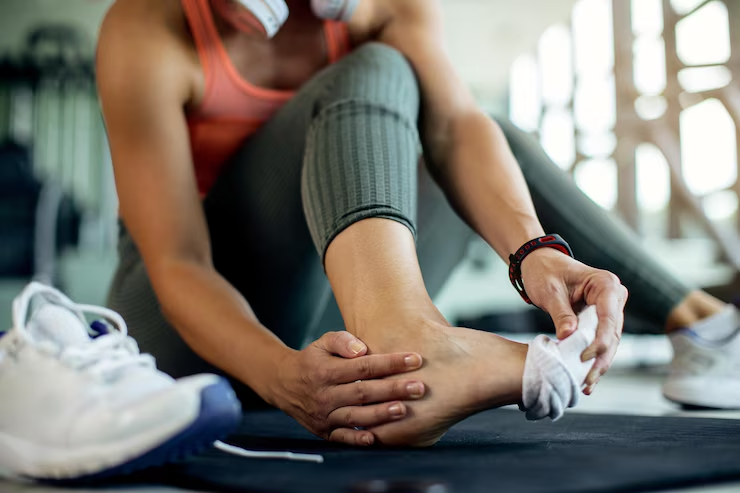You swing your legs around the bed and set your feet on the floor. Ouch. That first step causes stabbing, shooting heel pain. You are stuck for a moment. You wonder, leaping across the room, Why is my heel like this in the morning?
Don’t worry if that rings a bell; you are not alone. Morning foot pain is more common than you may realize and is usually linked to wholly treatable conditions, as long as you catch them early.
This guide will explain what’s happening and why your heel screams at you in the mornings, what may be happening behind the scenes, and, more importantly, how you can make yourself feel better. So, let’s begin.
Understanding the Nature of Morning Heel Pain
So, why mornings? Why not midday or late evening?
Here’s the thing: when you sleep, your body rests, including the muscles, tendons, and fascia in your feet. You’re lying still for hours. That stillness causes tissues especially in your lower legs and feet to tighten up. And when you stand and take your first step in th e morning? You’re suddenly stretching structures that have essentially gone on vacation overnight.
That’s why the pain is often worst right after waking up. Or even after sitting for an extended period during the day. But it tends to ease up as you move around. Your body’s warming up. Blood flows more freely, tissues stretch more easily, and the mechanics of your feet gradually stabilize.
The Anatomy at Play
Your foot isn’t a slab of bone and skin. It’s a complex system of ligaments, tendons, fat pads, and fascia that all work together to support your every step.
- Plantar fascia: This thick band of tissue runs along the bottom of your foot from heel to toes. It absorbs shock and supports your arch.
- Achilles tendon: Anchoring your calf muscle to your heel, this tendon allows for mobility and stability.
- Heel pad: This fatty cushion helps absorb the impact of walking.
- Calcaneus (heel bone): The base on which it all rests.
Most Common Cause: Plantar Fasciitis
If one had to identify a top villain, it would be plantar fasciitis. The condition is an inflammation of the plantar fascia, the strong band that runs from the heel bone to the toes.
So why does it hurt so much in the morning?
As you sleep, the plantar fascia tightens. As you step down, it suddenly contracts. That abrupt contraction of an irritated ligament? It’s lost flexibility like an overused rubber band, and each pull feels too much.
All About Plantar Fasciitis
What’s Happening Inside Your Foot?
Plantar fasciitis is not an inflammatory condition. The fascia, over time, suffers microtears close to its point of attachment at the heel. Chronic irritation can cause degeneration, weakening the structure and extending healing.
The Symptoms You’ll Notice
- A sharp, stabbing pain at the bottom of your heel.
- It’s worst in the morning or after being off your feet.
- It tends to lessen as you walk around, but might return after long periods of standing or exercise.
Who’s at Risk?
Your lifestyle and anatomy can stack the odds against you. You might be more likely to develop plantar fasciitis if you:
- Have flat feet or high arches.
- Walk barefoot on hard floors regularly. It will cause a stiff foot.
- Spend hours standing, especially on concrete or tile.
- Carry extra weight.
- Wear unsupportive shoes (we see you, flip-flops).
- Have tight calves or a rigid Achilles tendon.
Is It Always Plantar Fasciitis?
Not necessarily. Other conditions can mimic its pain pattern:
- Fat pad atrophy: When the protective cushion under your heel thins with age or overuse.
- Tarsal tunnel syndrome: A nerve-related condition causing burning, tingling, or numbness.
That’s why getting a proper diagnosis matters.
Contributing Factors
Footwear Choices
Shoes with little to no arch support can wreak havoc. The plantar fascia bears way more stress than it’s built for, and walking barefoot on tile or hardwood floors doesn’t help.
Weight Gain
Every extra pound adds pressure to your feet, especially your heels. If you’ve recently gained weight, that might be what tipped the scales.
Sudden Activity Spikes
You join a new workout class, start running again, or spend a weekend exploring a new city. Jumping into high-impact activity without gradual conditioning is a fast track to developing plantar fasciitis.
Tight Calf Muscles
They pull on the Achilles tendon, which then tugs on the heel and strains the plantar fascia. The plantar fascia is a connected chain; tightness anywhere in it can cause morning foot pain.
Prolonged Standing
Teachers, nurses, and retail workers. We see you. Standing on hard surfaces for hours daily, especially in unsupportive shoes, is a perfect storm for foot stress.
When to See a Doctor
Don’t wait if your morning foot pain is not improving after several weeks of home treatment. These are obvious indicators to consult medical advice:
- The pain is increasing or worsening.
- You notice redness, swelling, or bruising.
- You begin to limp or do not want to put weight on the foot.
- It’s disrupting your sleep or daily routines.
Having a specialist evaluate the problem might save long-term complications and provide a quicker path to recovery.
Diagnostic Evaluation
A clinician’s goal? Get to the root of your pain and rule out anything more serious.
What to Expect:
-
- History & Symptoms: When did the pain start? What does it feel like? Any recent changes in activity?
- Physical Exam: Your provider will press on key areas of your foot, assess your range of motion, and possibly observe how you walk.
- Imaging:
-
- X-rays: These help spot bone spurs or rule out fractures.
- Ultrasound: Ideal for seeing soft tissue inflammation.
- MRI: Reserved for persistent or complicated cases, offering detailed visuals of soft tissue injuries.
Home Remedies and Relief Options
If you catch plantar fasciitis early. You can do plenty of things right now to help it heal.
- Morning Stretch Routine: Before getting out of bed, flex and stretch your feet. Pull your toes back toward your shin. Loosen up those tissues before they bear your body weight.
- Ice After Exercise: Roll an icy water bottle under your foot for 10–15 minutes after a day at work or after exercise. This calms inflammation and gently lengthens the fascia.
- Footwear Solutions: Raised arch supports, cushioned insoles, or personalized orthotics may work wonders. Raising the heel of your shoes slightly may help take pressure off your Achilles and plantar fascia.
- Night Splints: These splints stretch your foot out in the evening, avoiding that agonizing morning “snap.”
- Over-the-Counter Assistance: NSAIDs such as ibuprofen are anti-inflammatory. But keep in mind: they’re part of a plan, not the answer.
Long-Term Management and Prevention
Even after the pain fades, your feet still need care. Keep up these habits to prevent the pain from returning:
- Stretch your calves daily.
- Avoid walking barefoot, especially on hard floors.
- Replace shoes regularly. Especially if you’re active or on your feet all day.
- Ease into new workouts. Build intensity gradually.
- Listen to your body. Pain is information, not just an inconvenience.



